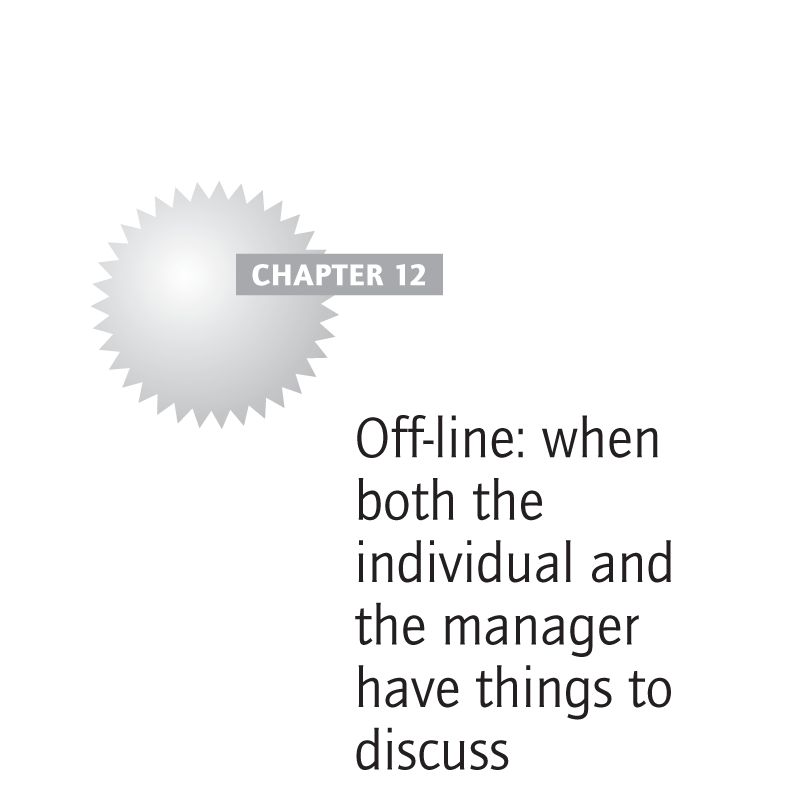This final off-line scenario builds on the previous two by presenting a situation where both the manager and the subordinate have things they want to discuss. For completeness, we’ll start at the beginning and demonstrate the opening of the conversation. But in this scenario your challenge is mostly about deciding what’s ‘coachable’ (what can be handled in a less directive style) and what’s not (you simply need to confirm, or give information). My challenge is to show how actually most things are coachable and that when you withhold your natural inclination to ‘tell’ you’ll discover this for yourself.
This time we’ll imagine that you’re with one of your team for a regular update meeting. They know they need to come prepared with their objectives, and they normally bring a list of these. There are also topics you’d like to discuss, so you want to add them into the list. The meeting is with Marion, who runs a small team in a busy call centre.

Stage 1: Establish conversation
Here’s the initial stage where you say hello, get comfortable and create a sense of a work-related conversation. As before, you’re in the best position to judge how formal or informal you need to be, but try to keep all these types of conversations as relaxed as possible. Too much ‘professional-speak’ can create a lack of equality in the conversation and also reduce rapport (and so openness).
| Manager | Marion, hi. Gosh it’s a bit cold in here, let me just adjust the thermostat. How are you, how are things? |
| Marion | Well, great really. Well, busy, as you know, I haven’t really got time for this, but it seems ages since I saw you. |
| Manager | I know, it’ll be Christmas next! Right, well, let’s get going – how long have we got for this, is it 30 minutes? |
| Marion | Yes, but if this room doesn’t warm up I’ll be out sooner than that! |
As you can see, lots of familiarity and rapport. Obviously if you don’t know someone too well you might be a little more formal, but you are in the best position to judge what’s appropriate with each individual.

Stop playing fix-it!
Coaching conversations are a challenge for managers, as they often have to listen to a problem which affects them in some way. For example, when your team member declares they can’t cope with their workload and you feel ultimately accountable for that. So most managers want to ‘fix’ the issue quickly, for example by telling subordinates what to do, or by taking action in some way. To coach effectively, it’s crucial that we go into coaching mode here, rather than ‘hear problem – fix problem’ mode. For you as a manager it may feel as though you have to stay quiet or ‘sit on your hands’ in the conversation. It demands both self-awareness, i.e. you need to realise you’ve gone into ‘fix-it’ mode, and also self-management. Over time, the whole process becomes more natural, especially once you see the benefits for yourself.
Stage 2: Identify clear topic and goal
Here we’ll build the topic together, as both the manager and Marion have things they want to discuss. It’s best to hear from Marion first, as she’s the person responsible for her situations. We also want to keep a sense that she needs to own getting the most out of the session, and needs to come ready to work in the conversation. Let’s continue the discussion.
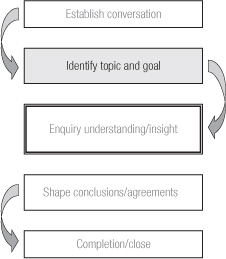
| Manager | Alright, so let’s just focus this a little then. Tell me, what would you like to get from this conversation? |
| Marion | Well, I want to talk about three things: the latest results of our fabulous push on sales – we’ve just heard how we’ve done so far with that; plus the budget requirements – I want some clarity about what’s needed on that. Oh, and I also want to get your input on a bit of an issue I’ve got with someone in my team. |
| Manager | Great, and I’d like to pick up with you from last time about the issues we were having with customer complaints and the turnaround times. |
| Marion | Ah yes, I’ve got some news on that too. |

The act of sharing feelings with another person. For example, if you’re upset I’ll get upset too, or if you’re sad, so am I.
Empathy
The ability to relate to, appreciate or understand the feelings of someone else, without necessarily taking on that emotion ourselves.
In coaching, empathy is normally more appropriate than sympathy. For example, ‘I can appreciate that this is upsetting’ is more appropriate than this expression of sympathy: ‘That’s awful, it’s making me angry too.’ In the first empathetic statement, we remain objective and impartial, whereas in the sympathetic example we also become angry and so less objective. You want to support the individual to stay resourceful in the conversation, and helping them stay angry might not help. Occasionally, however, empathy may appear cold and sympathy is more appropriate, for example in genuinely upsetting events such as crisis, loss or trauma.
What’s coachable and what’s not?
Now, from Marion’s and the manager’s lists, I hope you’ll notice that some of the topics seem more ‘coachable’ than others.
- The sales results: These are probably good news that Marion wants to share. Assuming that there isn’t an issue with them, i.e. they’re actually pretty good, then that’s probably not a topic that will be helped by the Coaching Path. However, you might want to ask a few coaching questions to foster learning, such as ‘So how can we build on these results going forward?’
- The budget requirements: This may indeed involve ‘giving clarity’: you’re either confirming or making clear what Marion needs to do according to the process. This may be an occasion where a directive style is more appropriate, for example ‘Yes, you’re right, that’s what we need’ or ‘No, we can’t do that’, etc. Or it might indeed be coachable, and Marion simply needs a little time and space to work out her own answers for herself. Perhaps she’s wondering how much to put in the budget for training this year and is hesitant to decide. By facilitating her thought processes you can help her.
- The issue with a member of her team: This appears the most obviously suited for the Coaching Path. After all, Marion is managing the individual and her ability to cope with them is key to her role. If she’s got an issue with someone, the best value you can add is probably to help her to decide how to tackle it.
- The customer complaints issue: This is also probably a coaching opportunity. It’s implied that this is an issue that Marion has already discussed and the manager wants an update. By using coaching tools such as enquiry and powerful questions, the manager can support Marion to stay resourceful around that situation.
Let’s move the conversation along this stage of the path: identify topic(s) and goal.
So there you have Marion’s topic, the objective and goal for the conversation. It’s a perfect topic to adopt a less directive posture on, as it’s all about Marion’s ability to deal with a difficult member of her team. There’s a temptation for the manager to become involved in what might be a ‘juicy issue’ and give advice in a potentially dramatic situation. But as a manager it’s easier to coach when you stay objective and impartial. After Marion’s last statement, the manager might easily choose to move on to the next stage, ‘enquiry and understanding’. So let’s do that.
Stage 3: Enquiry, understanding and insight
So here we move into enquiry mode around the situation with Kirsty. Remember that we’re seeking to understand – surfacing Marion’s thoughts, ideas and views – rather than trying to arrive at a smart solution to the situation. As always, we’re assuming the answers will come from Marion.
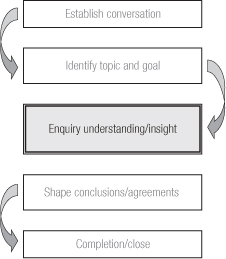
| Manager | Okay, can you tell me a little more about the situation with Kirsty then? |
| Marion | Well, on Friday things came to a head. I overheard Kirsty being really rude to a customer on the telephone and had to take her to one side and talk to her about it. |
| Manager | Okay. |
| Marion | And her attitude was the same as I’d experienced previously – she seems to lose her temper at the slightest thing and then regrets it later. She knew immediately that what she’d said to the customer was inappropriate, but once again in the heat of the moment she’d been defensive and argumentative. |
| Manager | And you’ve had these discussions before, haven’t you? |
| Marion | Oh yes, several times – at least five, I’d say. That’s what makes me think I should really consider letting her go. I suppose it’s not fair on the rest of the team really. |
| Manager | You seem a bit reluctant about that. |
Here the manager is adopting a more detached perspective – which is one of the benefits of not trying to ‘fix’ the issue, or give any advice. Because the manager is more detached, they are able to empathise, or relate to Marion’s apparent ‘mood’. By reflecting this back to Marion, it creates a worthwhile shift in the conversation.

Remember – coaching isn’t just asking questions
When we learn to coach we often assume that the principle ‘Don’t tell people what to do’ means ‘Make people think by asking questions’. So we assume that a coaching conversation is a series of questions and very little else. That’s not true! Asking someone a list of questions can place them (and you) under pressure, so remember to do all the other conversational ‘stuff ’ like summarising, confirming, musing or ‘waffle’ – for example ‘Right, got it, that’s quite a large piece of work then, isn’t it?’ or ‘Right . . . okay . . . oh . . . ’ Take the pressure off and let it feel natural – remember, coaching is always a conversation. The behaviours outlined in Chapter 8 – ‘A flexible style of influence’ – will enable your coaching conversations to flow naturally.
To continue the conversation:
| Marion | Well, to be fair, I am. I mean she’s a nice girl, a lovely girl really, she can just be a bit immature, if you know what I mean. She just needs to calm down a bit, you know, realise it’s not school and it’s not a teacher that’s telling her off – it’s a customer who often has a genuine cause for complaint. |
| Manager | So what causes her to lose her temper, do you think? |
| Marion | [pauses] You know, I think it’s that she takes things personally. It’s like it’s her against the customer, or even the world! It’s not like she’s even the one that’s at fault, it’s the service engineers who have often made the mistake. But you’d think to admit we’ve made a mistake would kill her. |
| Manager | So what are you thinking of doing? |
| Marion | Well, on Friday I honestly felt like ‘enough is enough’, and accepting that things just aren’t going to change. |
| Manager | And now? |
Again, the manager is able to notice what isn’t being said, because of their objective view of the conversation. Marion is in two minds. The manager’s role is to help her decide what she wants to do.
| Marion | Oh, I don’t know – take her by the scruff of the neck probably! She’s such a feisty character. I just feel she’s got real potential, you know – she’s got more about her than most people her age. Maybe she just needs some training or something. |
| Manager | So what are you considering? |
That last question is what I’d call ‘artfully vague’, in that it leaves the potential response very broad, while moving the conversation on a little by beginning to probe for potential conclusions.
| Marion | I’m not sure. I think she’d benefit from hearing how she’s supposed to handle difficult customers. She could do with taking a leaf out of Neil’s book – he’d make a good peacekeeper for the UN, that one. |
| Manager | Is that possible? |
| Marion | You know, it probably is. I mean, we could soon hook her up to the call recording equipment and she could listen to some of Neil’s calls on playback. |
Again, our manager is doing very little except to facilitate Marion’s thoughts, and allow her to express her thoughts and feelings. The benefit is that Marion appears to be getting clearer in her own mind and making her own decisions. We’re now ready to go to the next stage, ‘shape conclusions and agreements’.
Stage 4: Shape agreements and conclusions
In this stage we pull the conversation together, so Marion can decide what she’s got from the conversation and also be clear about what she’s decided to do going forwards.
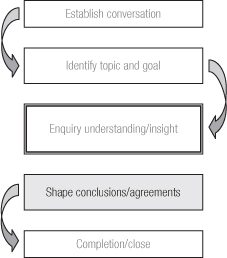
| Manager | Alright, so what have you dec-ided in this conversation? |
| Marion | [laughs] Well, I’m obviously not going to sack her, am I? I think she’s my own personal challenge or something. |
| Manager | [laughs] Yes, I do think it sounds like she’s worth trying something different with. What are you going to do? |
| Marion | I’m going to get her to sit next to Neil, and I’m also going to get her to listen to some of his calls. And if that doesn’t work I’m going to run out screaming or something! |
| Manager | [laughs] Okay, so if that happens I’ll know who’s to blame! I do think it’s a good plan though – let me know how you get on, I’ll be interested to hear. |
Marion has benefited from getting the problem off her chest and also from finding out how she really feels, now her initial frustration has been expressed. I know that Marion and the manager had more topics for discussion, but for the purposes of illustration, we’ll end it here. If we were to continue with those other topics, we’d simply pick one of the other items on the agenda and take it straight to the second stage, ‘identify topic and goal’. But with this topic, we’re now ready to move to the final stage: ‘completion and close’.
Stage 5: Completion and close
So now we check that it’s okay to close the conversation, and then end it in an appropriate way. Given the familiarity between Marion and her manager, it’s straightforward.
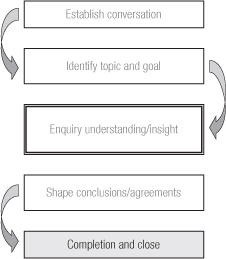
| Manager | Alright, Marion, so let me just check – are we okay to close this here? |
| Marion | Yes, that’s fine. I’m happy with where we’ve got to. |
| Manager | Right, well, let’s end there then. I guess you’ll be wanting to get back. |
| Marion | I am – I’ve got a customer call-back to do before 3 p.m. Anyway, I’ll see you again. Thanks for that. |
Please notice that the relaxed and informal style of this conversation is an indication of confident and effective coaching. Again, it’s important that you retain your own natural conversational style, while adopting simple principles such as listening more, talking less and assuming that someone else can come up with valid insights, conclusions and ideas.

